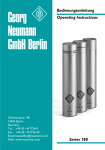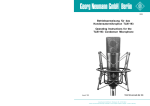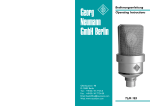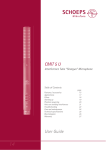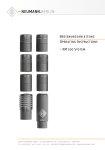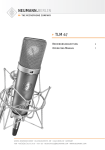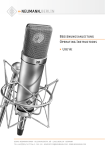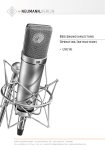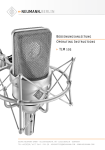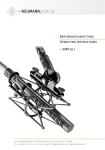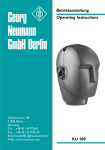Download Bedienungsanleitung Operating Instructions USM 69 i
Transcript
Bedienungsanleitung Operating Instructions MARKETING / VERTRIEB ENTWICKLUNG / SERVICE Ollenhauerstr. 98 D-13403 Berlin Tel.: (030) 41 77 24-0 Fax: (030) 41 77 24-50 FERTIGUNG / LAGER Am Labor 1 D-30900 Wedemark USM 69 i Inhaltsverzeichnis Table of Contents 1. Das Kondensator-Stereo-Mikrophon USM 69 i 1. The USM 69 i Stereo Condenser Microphone 2. Richtcharakteristik-Umschaltung 2. Directional Pattern Selection 3. Ausführungsformen und Beschaltung des Ausgangs 3. Microphone Versions and Output Wiring 4. Microphone Cables 5. Power Supply 6. Operation with Unbalanced or Center Tap Grounded Inputs 7. Disassembly, Test Adapter 8. Technical Specifications and Circuit Diagramm 9. Frequency Response and Polar Patterns 4. Mikrophonkabel 5. Stromversorgung 6. Betrieb an unsymmetrischen und mittengeerdeten Eingängen 7. Zerlegen des Mikrophons, Meßadapter 8. Technische Daten und Schaltbild 9. Frequenzgänge und Polardiagramme 10. Accessories 10. Zubehör 1. Das Kondensator-StereoMikrophon USM 69 i 1. The USM 69 i Stereo Condenser Microphone Das Kondensator-Stereo-Mikrophon USM 69 i ist ein or tsumschaltbares Studiomikrophon der Serie fet 80 für die stereophone Aufnahmetechnik. Seine akustischen Wandlereigenschaften gleichen denen des bekannten fernumschaltbaren Stereomikrophons SM 69 fet, dessen Kapselaufbau unveränder t übernommen wurde. The USM 69 i stereo condenser microphone is a fet 80 series studio microphone for high quality stereo recordings featuring built-in directional pattern selectors. Its acoustical characteristics are identical to those of the well-known SM 69 fet stereo condenser microphone since the entire capsule configuration has been adopted from it unchanged. Wie dieses Mikrophon besteht es aus dem Kapselkopf, in dem zwei getrennte, voneinander unabhängige Mikrophonkapseln mit Membranen aus goldbedampften Polyesterfolien angeordnet sind, und dem Verstärkerteil, der zwei voneinander unabhängige Mikrophonverstärker enthält. Beide Kapseln sind dicht übereinander angeordnet; das obere System kann gegenüber dem unteren um 270° verdreht werden. Dadurch ist es möglich, mit diesem Mikrophon Aufnahmen nach dem Prinzip der Intensitäts-Stereophonie (MS und XY) zu machen. Bei derartigen Aufnahmen erzeugen aus verschiedenen Richtungen einwirkende Schallquellen in beiden Mikrophonkapseln nur Intensitäts-, nicht aber Laufzeitunterschiede, und es ist möglich, beide Signale für eine gute Einkanalwiedergabe zu addieren, ohne daß es zu Interferenzen kommt. Die auf dem unteren Kapselsystem angeordneten Farbpunkte können dabei als Orientierungshilfe für den Winkel dienen, um den das obere Kapselsystem gegenüber dem unteren verdreht wurde. As in the SM 69 fet, the microphone head of the USM 69 i houses two completely separate condenser elements with gold-coated polyester film membranes, mounted one abvove the other and each associated with two completely separate microphone preamps. The upper capsule may be rotated against the lower one through an arc of 270 degrees. This makes intensity stereo recording (MS or XY) possible. With this technique sounds impinging from different directions produce only intensity differences, yet no delay (phase) differences between the two systems. As a result, both signals may be combined to obtain good mono reproduction without phase cancellation interference. Color marks on the lower capsule grille indicate the angle between the axes of maximum sensitivity of the upper and the lower capsule (pick-up angles). Außer als Stereo-Mikrophon läßt sich das USM 69 i auch überall verwenden, wo an einem Or t zwei Ein- Both microphone systems are electrically independent of one another. The other microphone preamp will not In addition, the USM 69 i may be used to drive mono channels where two independent microphones or a back-up system are needed at the same location. 2 kanal-Mikrophone benötigt werden oder wo für eine Einkanalaufnahme das zweite System als Reservemikrophon dienen soll. be affected, even with an earth (ground) fault of the supply voltage in one channel or shor ting of one output. Beide Mikrophonsysteme arbeiten unabhängig voneinander. Sogar bei Erdschluß der Speisespannung in einem der Kanäle oder beim Kurzschluß eines Ausgangs arbeitet der zweite Mikrophonverstärker ungestört weiter. The preamplifiers of the USM 69 i are designed as operational amplifiers offering additional headroom and particularly low equivalent noise. The USM 69 i therefore picks up both distant sound sources as well as extremely loud sound sources at close proximity without difficulty. Die Verstärker des USM 69 i sind trotz besonders geringen Eigenrauschens sehr weit aussteuerbar. Daher sind Aufnahmen sehr lauter Schallquellen in größerem Abstand wie auch im Nahbereich problemlos möglich. Both preamps are equipped with an active filter blocking subaudio sound (as may be caused by mechanical shock or wind) ahead of the output transformers preventing the latter from being overloaded. Jeder Verstärker enthält ein aktives Filter, das unterhörfrequente Spannungen, wie sie durch Trittschall oder Wind entstehen können, sperrt und zugleich verhindert, daß die Ausgangstransformatoren durch diese – sonst unhörbaren – Schallanteile übersteuert werden. Several design features render this microphone largely immune not only to parasitic alternating currents in the cable shield, so-called ac-induced hum, but also to interference caused by radio and TV transmitters as well as radar equipment. Should however such interferences happen, as e. g. caused by inadaquate wiring, please ask for our information 83218. Durch verschiedene Maßnahmen wurde dieses Mikrophon außer gegen parasitäre Wechselströme im Kabelschirm (sogenannte Brummschleifen usw.) auch gegen Störungen durch Rundfunk- und Fernsehsender sowie durch Radargeräte besonders störfest gemacht. Sollten unter extremen Bedingungen – meist infolge unzweckmäßiger Verkabelung – dennoch solche Störungen auftreten, fordern Sie bitte unser Informationsblatt 83218 an. 2. Richtcharakteristik-Umschaltung 2. Directional Pattern Selection Im Gegensatz zum SM 69 fet wird die Richtcharakteristik beider Kapseln mittels zweier Drehschalter im Mikrophon selbst umgeschaltet. Das Mikrophon benötigt daher kein spezielles Netz- oder sonstiges Anschlußgerät, sondern seine beiden Ausgänge können direkt auf alle für die P-48-Phantomspeisung ausgelegten Anschlüsse geschaltet werden. By contrast to the SM 69 fet the USM 69 i features two flush-mounted rotary directional pattern selectors. Therefore, no special ac power supply unit or powering adapters are needed. The two outputs of the USM 69 i connect directly to any 48-volt-phantom powered outlets. Besides the three usual ones – omni, cardioid, figure-8 – the intermediate polar patterns wide-angle cardioid and hypercardioid are selectable. Außer den drei üblichen Richtcharakteristiken – Kugel, Niere, Acht – kann jede Kapsel auch auf die Zwischenstellungen „Hyperniere“ und „breite Niere“ geschaltet werden. A built-in dc converter generates the required capsule bias voltages. Its reliable operation is ensured even if only one of the two microphone systems is being used. Its simple and largely fail-safe circuitry assures a low failure rate, but should the dc conver ter ever fail, a special diode circuit in the microphone ensures that both capsule systems will keep operating even if only with cardioid directional pattern and a 3 dB reduced sensitivity. Die erforderlichen Kapselvorspannungen erzeugt ein eingebauter Gleichspannungswandler. Er arbeitet auch dann zuverlässig, wenn nur eines der beiden Systeme betrieben und angeschlossen wird. Obwohl dank seiner einfachen und betriebssicheren Schaltung Ausfälle nicht zu befürchten sind, stellt eine Diodenschaltung im Mikrophon sicher, daß beide Systeme auch bei einem Versagen des Gleichspannungswandlers weiterarbeiten. Sie schalten sich dabei in die Richtcharakteristik „Niere“. Das Übertragungsmaß sinkt um ca. 3 dB. 3 3. Ausführungsformen und Beschaltung des Ausgangs 3. Microphone Versions and Output Wiring Das Mikrophon kann in den folgenden Ausführungsformen geliefert werden: The following versions are provided: USM 69 i: With male 5-pole Switchcraft connector insert wired per IEC 268-12 (pin conn. 130-x-IEC-06) or DIN 45 599 H, respectively: USM 69 i: Mit 5poligem Switchcraft-Steckereinsatz, beschaltet nach DIN 45 599, Kennzeichen „H“ bzw. IEC 268-12 (Pin conn. 130-x-IEC-06): System I: Lower capsule (not rotable). The axis of maximum sensitivity is indicated by the Neumann emblem. Yellow (lower) directional pattern selector. Modulation connects to pins 2 (+) and 3. System I: Untere, nicht verdrehbare Kapsel, das Firmenschild kennzeichnet die Hauptempfangsrichtung, gelber (unterer) Charakteristikumschalter, Anschluß über Stifte 2(+) und 3. System II: Obere, verdrehbare Kapsel, ein Nippel auf dem unteren Ring der Kapsel kennzeichnet die Hauptempfangsrichtung, roter (oberer) Charakteristikumschalter, Anschluß über Stifte 4(+) und 5. System II: Upper capsule (rotatable). The axis of maximum sensitivity is indicated by an embossed dot on the lower rim of the upper capsule cage. Red (upper) directional pattern selector. Modulation connects to pins 4 (+) and 5. Hierbei kennzeichnet (+) die Polarität bei Druckanstieg vor der Membran. Stift 1: Gehäuse und 0 Volt. Erforderliches Gegenstück: Switchcraft A5F. A sudden rise in sound pressure in front of the front membrane causes a positive voltage to appear at the pins marked (+). Pin 1: 0 V and shield. Required female connector : Switchcraft A 5 F. USM 69 i mt: Wie oben, jedoch mit dunkel mattierter Oberfläche. USM 69 i mt: As above, but with dark matt finish. 4. Mikrophonkabel 4. Microphone Cables Das USM 69 i hat einen 5poligen Switchcraft-Steckereinsatz. Es kann über das 10 m lange Mikrophonkabel IC 5 (ohne) oder IC 6 (mit Stativgelenkkupplung) oder auch direkt auf das 1 m lange Adapterkabel AC 20 geschaltet werden, das die beiden Mikrophonausgänge auf je einen 3poligen Switchcraft-Stecker führt. The USM 69 i has a male 5-pole Switchcraft connector insert. The microphone may be connected either to the 10-m (33 ft.) cable IC 5 (without swivel mount) or IC 6 (with swivel mount) or to the 1-m adapter cable AC 20 which splits the two stereo channels so that they are separately available at one male 3-pole Switchraft connector (A 3 M) each. Eine weitere Verlängerung ist mit den Kabeln IC 3 (Switchcraft) möglich. Further extension is possible using cables IC 3. Die Kabel IC 5 und IC 6 sind auch mit dunkel mattierter Stativgelenkkupplung lieferbar und tragen dann die Bezeichnung IC 5 mt bzw. IC 6 mt. Cables IC 5 and IC 6 are also available with matt black connector and matt black swivel mount, respectively, and are then referred to as IC 5 mt and IC 6 mt. Andere Kabellängen sind auf Wunsch lieferbar. Other cable lengths on special order. Die höchste zulässige Kabellänge beträgt etwa 300 m. Bei größeren Kabellängen beeinflußt die Kabelkapazität den Frequenzgang und führ t in Verbindung mit der Streuinduktivität des Mikrophonübertragers zunächst zu einem Anstieg am oberen Ende des Übertragungsbereichs. The cable length between microphone and following pre-amplifier should not exceed 300 m (980 ft.). The capacitance of greater cable lengths could affect the frequency response and, in conjunction with the leakage inductance of the micorphone’s output transformer, would result in a rise at the upper end of the frequency range. 4 5. Stromversorgung 5. Power Supply 5.1 Phamtomspeisung 5.1 Phantom Powering Die Mikrophone der Serie fet 80 werden mit 48 V phantomgespeist (P 48, DIN 45 596/IEC 268-15). Bei der Phantomspeisung fließt der Speisestrom vom positiven Pol der Spannungsquelle über die elektrische Mitte der beiden Modulationsadern zum Mikrophon. Er wird hierzu über zwei gleichgroße Widerstände beiden Tonadern gleichsinnig zugeführt. Die Rückleitung des Gleichstroms erfolgt über den Kabelschirm. Zwischen beiden Modulationsadern besteht also keine Potentialdifferenz. Daher ist mit der Phantomspeisung eine kompatible Anschlußtechnik möglich: Auf die Anschlußdosen können wahlweise auch dynamische Mikrophone oder Bändchenmikrophone sowie die Modulationskabel röhrenbestückter Kondensatormikrophone geschaltet werden, ohne daß die Speisegleichspannung abgeschaltet werden muß. The fet 80-Series microphones are phantom-powered at 48 V (P 48, DIN 45 596 / IEC 268-15). With phantom powering the dc from the positive supply terminal is divided via two identical resistors, one half of the dc flowing through each audio (modulation) conductor to the microphone, and returning to the voltage source via the cable shield. Phantom powering provides a fully compatible connecting system, since no potential differences exist between the two audio conductors. Studio outlets so powered will therefore also accept dynamic microphones and ribbon microphones as well as the modulation conductors of tube-equipped condenser microphones without the need to switch off the dc supply voltage. No harm is done even if a phantom power supply is connected to an outlet which is centrally phantom powered. Der Ausgang eines Phantomspeisegerätes darf auch auf bereits anderweitig phantomgespeiste Mikrophoneingänge gesteckt werden. 5.2 Ac Supply Operation 5.2 Betrieb mit Netzgeräten All P 48 power supplies according to IEC 268-15 and DIN 45 596, delivering at least 2 mA per channel, are suitable for powering the microphones. The Neumann P 48 power supply unit bears the designation N48i-2. Für die Stromversorgung sind alle P 48-Netzgeräte geeignet, die mindestens 2 mA je Kanal abgeben. Das entsprechende Neumann P 48-Netzgerät hat die Bezeichnung N 48 i-2. It is designed to power two mono condenser microphones or one stereo microphone at 48 V ± 1 V, max. 2 x 5 mA. See Neumann bulletin No. 10000821.. “Phantom 48 Vdc Power Supplies”. Es ist zur Stromversorgung zweier Mono-Kondensatormikrophone oder eines Stereomikrophons mit 48 V ± 1 V, maximal 2 x 5 mA, geeignet (siehe auch Neumann-Druckschrift 10000 821.. „48 V-Phantomspeisegeräte“). Modulation polarity at the power supply is identical with that at the microphone. If more than two microphones are to be powered, a permanently wired central powering system is recommended. Die Zuordnung der Mikrophonanschlüsse und die Polarität der Modulationsadern ist am Ausgang der Speisegeräte die gleiche wie am Mikrophon. See Neumann bulletin No. 10000 817.. “Central powering”: Werden mehrere Mikrophone betrieben, so können diese über eine feste Verdrahtung aus einem Gerät für Sammelspeisung versorgt werden (siehe auch Neumann Druckschrift 10000 817.. „Sammelspeisung“): N 448 A ac mains operated central powering unit, 48 V, maximum current output 100 mA. Plug-in PC board . N 448 A Netzgerät, Stromabgabe maximal 100 mA, Steckkarte im Europaformat. GW 2448 KA dc-to-dc converter using 24 Vdc operating voltage. Maximum current output 50 mA. Plug-in PC board. GW 2448 KA Gleichspannungswandler für den Anschluß an eine 24 V-Stromversorgung. Stromabgabe maximal 50 mA, Steckkarte im Europaformat. 5 5.3 Batteriespeisung 5.3 Battery Powering Steht keine Netzspannung zur Verfügung, kann die Speisung mit einem Batteriespeisegerät BS 48 i-2 erfolgen. Dieses liefert 48 V ± 1V, maximal je 5 mA, und wird jeweils von einer 9 Volt-Blockbatterie Typ IEC 6 F 22 gespeist. If a mains power source is not available, power can be supplied by the unit BS 48 i-2. It delivers 48 V± 1 V, at 5 mA maximum, and is powered by a 9-volt monobloc battery Type IEC6F22. A microphone of the fet 80-Series can be operated for at least 20 hours on a BS 48 i. See Neumann bulletin 10000821... “Phantom 48 Vdc Power Supplies”. Ein Mikrophon der Serie fet 80 kann mit einem BS 48 i-2 mindestens 20 Stunden betrieben werden (siehe auch Neumann-Druckschrift 10000 821.. „48 V-Phantomspeisegeräte“). The assignment of the microphone terminals and the polarity of the modulation leads is the same at the output of the power units as it is at the microphone. Die Zuordnung der Mikrophonanschlüsse und die Polarität der Modulationsadern ist am Ausgang der Speisegeräte die gleiche wie am Mikrophon. 6. Betrieb an unsymmetrischen oder mittengeerdeten Eingängen 6. Operation with Unbalanced or Center Tap Grounded Inputs Die 48 V-Phantomspeisegeräte BS 48 i-2 und N 48 i-2 haben gleichspannungsfreie Ausgänge, so daß für den Anschluß an einen unsymmetrischen Eingang kein Übertrager erforderlich ist. The 48 V phantompowering units BS 48 i-2 and N 48 i-2 have dc-free outputs, so that no transformer is required for connecting to an unbalanced input. In the case of the USM 69 i stereo condenser microphone pin 2 and pin 4 are the “hot phases”. Pin 3 and 5 must be connected to earth. Beim USM 69 i sind jeweils Pin 2 und 4 die „heiße Phase“. Pin 3 und Pin 5 müssen für unsymmetrische Eingänge an Masse gelegt werden. In the case of many other phantom powering units (except those mentioned above), not only the modulation leads to the microphone, but also the outgoing modulation leads from the pow-ering unit, are at the potential of the feed voltage (+ 48 V). Bei vielen anderen als den o.g. Phantomspeisegeräten liegen nicht nur die Modulationsleitungen zum Mikrophon auf dem Potential der Speisespannung von + 48 V, sondern auch die vom Speisegerät abgehenden ModulatiThis is of no signifionsleitungen. Für die cance for the balin der Studiotechnik anced, floating amplifiallgemein üblichen er and mixing console symmetrischen und inputs in general stuerdfreien Verstärker dio use. On the other und Mischpulteingänhand, the feed voltage ge ist dies ohne Bewill be short-circuited deutung. Dagegen when connected to Abbildung 1 / Figure 1 wird die Speisespansingle-sided or center nung beim Anschluß tap grounded amplifian einseitig oder mittengeerdete Verstärkereingänge er inputs, and no operation will be possible. This can kurzgeschlossen, und es ist kein Betrieb möglich. Dann be circum-vented as follows: bestehen folgende Lösungsmöglichkeiten: a) In center tap grounded equipment with input transa) In mittengeerdeten Geräten mit Eingangsübertrager former (e.g. some NAGRA units), the earth lead can (z.B. einige NAGRA-Geräte) kann die betreffende Erdalmost always be disconnected without affecting the verbindung fast immer ohne Nachteile für die Funktion function of the equipment. des Gerätes aufgetrennt werden. 6 b) In jede abgehende Modulationsleitung kann zur Abblockung der 48 V-Gleichspannung eine RC-Kombination eingefügt werden (siehe Abbildung 1 und Neumann-Information Nr. 84 221). b) In every outgoing modulation lead, an RC network can be incorporated to block the 48 Vdc voltage 7. Zerlegen des Mikrophons, Meßadapter 7. Disassembly, Test Adapter Nach Herausdrehen der drei oberen Kreuzschlitzschrauben kann der Kapselkopf abgezogen werden. An seine Stelle kann man den Meßadapter MA 69 U aufstecken, diesem eine tonfrequente Spannung zuführen und damit den Mikrophonverstärker über feste Kapselersatz-Kapazitäten in gleicher Weise beaufschlagen, wie dies beim Auftreffen einer Schallwelle auf die Mikrophonkapsel der Fall wäre. Die meisten Verstärkerdaten können so direkt überprüft werden: Verstärkung, Frequenzgang, Aussteuerbarkeit, Eigenstörspannung. The capsule head may be slipped off after unscrewing the three visible Phillips screws and replaced by the MA 69 U test adapter. If an audio frequency voltage is now applied to the test adapter, the load on the preamplifier via the test adapter capacitance (identical to that of the capsule) will be the same as that of a corresponding alternating sound pressure impinging on the microphone capsule. This enables the most important specifications to be measured directly: gain, frequency response, output capability, unweighted as well as weighted self-noise levels and distortion. (See Figure 1 and Neumann-Information no. 84222). Der Eingangswiderstand des Meßeingangs beträgt ca. 600 Ohm. Der erforderliche Stecker (LEMO Typ F, Größe 0) liegt dem Meßadapter bei. Input resistance of test input: approx. 600 ohms. A test connector (LEMO, F-type, size 0) is included. Ein Schiebeschalter im Meßkopf gestattet es, wahlweise System I (gelb) oder System II (rot) zu beaufschlagen. A slide switch on the test adapter routes the test voltage either to system I (yellow) or to system II (red). Sollwerte für das USM 69 i sind (Toleranz ± 0,5 dB): The nominal values for the USM 69 i are as follows ( ± 0.5 dB tolerance): Spannungsverstärkung ................................................... -2,5 dB (1 kHz, Abschluß 1 kOhm) Voltage gain (1 kHz, 1 kohm termination) ........ -2.5 dB Rel. gain at 40 Hz .......................................... -4.5 dB ± 1 dB at 16 kHz ..................................................................................... 0 dB Rel. Verstärkung bei 40 Hz ........................ -4,5 dB ± 1 dB bei 16 kHz .................................................................................. 0 dB Ein(max) = 1 kHz ac voltage applied to the test input for which THD should be less than 0.5 % at the 150 ohm output terminated in 1 kohm ........... 1.4 Vr ms UE(max) = an den Meßeingang gelegte Eingangswechselspannung (1 kHz), für die der Klirrfaktor am mit 1 kOhm belasteten Ausgang unter 0,5 % bleiben soll .............................................................................................. 1,4 Veff Current consumption (at 48 V) ..... 2 x 0.7 ± 0.05 mA Stromaufnahme (bei 48 Volt) .......... 2 x 0,7 ± 0,05 mA Nominal self-noise levels: Eigenstörspannungen: Reference: 0.775 V, peak to peak, tolerance: +1 dB Sollwerte (Spitzenwerte, Tol. +1 dB; 0,775 V 0 dB) Unweighted self-noise level ...................................... -106 dB Eigenstörspannungspegel, unbewertet ............... -106 dB Self-noise level weighted according to CCIR 468-1 (1976) ........................................................ -107 dB Eigenstörspannungspegel, DIN 45 405 .............. -111 dB Self-noise level weighted according to DIN 45 405 (1967) ....................................................... -111 dB Eigenstörspannungspegel, CCIR 468-1 (1976) -107 dB Nach Linksdrehen der beiden Kreuzschlitzschrauben oberhalb und unterhalb der Charakteristikumschalter und der drei unteren Schrauben kann auch das Gehäuserohr des Mikrophons nach oben abgezogen werden. Dabei sind die Drehknöpfe der Umschalter etwas hineinzudrücken. To remove the tubular housing, turn the two Phillips screws above and below the directional pattern selectors anticlockwise and unscrew the three bottom screws. When removing the tubular housing push the rotary selector switches slightly inward. 7 8. Technische Daten und Schaltbild 8. Technical Specifications and Circuit Diagramm Akust. Arbeitsweise ............ Druckgradientenempfänger Acoustical operating principle ............. Pressure gradient transducer Richtcharakteristik .................. Kugel, breite Niere, Niere, Hyperniere, Acht Polar pattern ............................. Omni, wide-angle cardioid, cardioid, hyper cardioid, figure-8 Übertragungsbereich ..................................... 40...16 000 Hz Frequency range ............................................... 40...16 000 Hz Feldbetriebsübertragungsfaktor bei 1 kHz ........................................................ 13 mV/Pa ± 1 dB Sensitivity ........................................................ 13 mV/Pa ± 1 dB Nennimpedanz .............................................................. 150 Ohm Source impedance ..................................................... 150 ohms Nennabschlußimpedanz ....................................... 1000 Ohm Minimum load impedance .................................. 1000 ohms Geräuschpegelabstand (bezogen auf 1 Pa bei 1 kHz DIN 45 590 / DIN 45 405, CCIR 468-3) ............. 70 dB S/N ratio (related to 1 Pa at 1 kHz, DIN 45 590 / DIN 45 405, CCIR 468-3) ............. 70 dB Equivalent noise level (DIN 45 590 / DIN 45 405, CCIR 468-3) ........... 24 dB Ersatzgeräuschpegel DIN 45 590 / DIN 45 405, CCIR 468-3) ............. 24 dB A-weighted equivalent loudness level due to inherent noise (DIN 45 634, IEC 179) .................................................... 13 dB A-bewerteter Äquivalentschalldruckpegel, bedingt durch innere Störquellen (DIN 45 634, IEC 179) .................................................... 13 dB Max. SPL for 0.5 % THD at 1 kHz ....... 132 dB 85 Pa with max. output voltage ......................................... 1100 mV Grenzschalldruckpegel bei 1 kHz für 0,5 % Klirrfaktor ....................................... 132 dB 85 Pa max. Ausgangsspannung dabei .............................. 1100 mV Power supply (P 48, DIN 45 596) .............. +48 V ± 4 V Current consumption ........................................... 2 x 0.7 mA Phantomspeisespannung (P 48, DIN 45 596) .................................................. 48 V ± 4 V Weight ................................................................... 560 g (20 ozs.) Dimensions ........................................................ ∅ 30 mm (1.2") and 48 mm (1.9") in diam. 292.5 mm (11.7") long Speisestrom ................................................................ 2 x 0,7 mA Gewicht ...................................................................................... 560 g Abmessungen .............................................. ∅ 30 und 48 mm, 292,5 mm lang 0 dB 0 dB 20 µPa 20 µPa 8 9 9. Frequenzgänge und Polardiagramme Frequency Response and Polar Patterns ° 20Hz 40Hz 80Hz 160Hz ° ° ° ° 10 11 10. Zubehör 10. Accessories Die meisten Tisch-, Fußbodenständer etc. haben ein 5/8"-27-Gang-Gewinde. Ein Reduzierstück (Bestell-Nr. 8421400018) für 3/8" und 1/2"-Gewindeanschluß wird mitgeliefert. Es ist auch einzeln erhältlich. Most of the table stands, floor stands etc. have a 5/8"27 thread. An adapter (Parts Catalog No. 8421 400018) can be supplied to provide compatability with 3/8" and 1/2" threads. Als Zubehör ist ein Etui mit Formeinsatz und Metallschloß lieferbar. A jeweller’s case with insert and metal locking is available as special accessory. Summen- und Differenzübertrager Z 240 Z 240 Matrix Transformers Der Transformator Z 240 ist ein hochwertiger Differentialübertrager, der - jeweils paarweise geliefert und zusammengeschaltet - für die Umsetzung von Stereosignalen vorgesehen ist. Es können die Mitten- und Seiteninformation in Rechts-Links-Signale umgesetzt werden und umgekehr t. Ein Mu-Metall-Gehäuse schirmt den Transformator ab. Die Wicklungsenden sind an Lötanschlüsse geführ t. Das Übersetzungsverhältnis der Über trager beträgt 1:(0,7+0,7). The Z 240 are high quality sum and difference (matrixing) transformers supplied in pairs. They are used for the conversion of stereophonic signals, i.e. of MS signals into left/right signals and vice versa.The transformers are mu-metal shielded. All winding ends are connected to external soldering lugs. The turns ratio is 1:(0.7 +0.7). Schwinggummi Z 26 Z 26 Rubber Shock Mount Das Schwinggummi Z 26 wird zur Verhinderung von Körperschallübertragung zwischen Stativ und Stativgelenk geschraubt. Es hat einen Gewindezapfen 1/2" und einen Gewindeanschluß 5/8"-27-Gang mit Reduzierstück für 1/2"- und 3/8"-Gewinde und verlängert um 45 mm. The Z 26 shock mount is used to prevent mechanical vibration interference between the stand and the swivel mount. It has a 1/2" male and a 5/8"-27 female thread. A 5/8"-27 male stud is available. The shock mount increases net microphone length by 45 mm (1.6"). Mikrophon-Neigevorrichtung MNV 87 mt MNV 87 mt Auditorium Hanger Die Mikrophon-Neigevorrichtung MNV 87 eignet sich für alle Mikrophone bei Verwendung eines Mikrophonkabels mit Stativgelenkkupplung. Sie besteht aus Kabelhalterung und einem Gewindezapfen. Mit diesem wird sie an den Gewindeanschluß der Stativgelenkkupplung angeschraubt und ermöglicht dann die Einstellung der Mikrophonneigung bei frei am Kabel hängendem Mikrophon. The MNV 87 auditorium hanger is suitable for all makes of microphones using a microphone cable with a swivel mount. The MNV 87 consists of a cable clamp and a stud with which it is screwed into the threaded coupling of the swivel mount. The microphone may then be tilted as needed because it is suspended from the MNV 87 and not from its own cable. Elastische Mikrophonaufhängung EA 30 a EA 30 a Elastic Suspension Zum Fernhalten mechanischer Erschütterungen, die als Körperschall über Stativ oder Aufhängung an das Mikrophon gelangen, empfiehlt sich die Verwendung besonderer Aufhängevorrichtungen. Für das USM 69 i bietet die elastische Aufhängung einen besonders wirksamen Schutz. Sie ist mit einem schwenkbaren Anschlußstück für Stativgewinde 3/8", 1/2", 5/8"-27-Gang ausgestattet. The use of an elastic microphone suspension is recommended for stand and boom mounting to prevent the microphone from being exposed to mechanical vibrations caused by structure borne shock waves which could travel along the microphone stand or the microphone mount. With the USM 69 i the EA 30 a elastic suspension is particularly effective. This accessory has tilting 5/8"-27 femnale thread. Elastische Mikrophonaufhängung EA 30 a mt EA 30 a mt Elastic Suspension Wie EA 30 a, jedoch dunkel mattiert. Same as EA 30 a, however, matt black. 12 Z 240 Z 26 EA 30 a MNV 87 WS 69 MF 3 MF 4 13 Tischständer MF 3 MF3 Table Stand Tischständer mit Eisenfuß, 1,6 kg schwer, Durchmesser 110 mm. Der Ständer ist schwarzmatt lackiert und steht gleitfest auf einer Moosgummi-Scheibe. Ein umwendbarer Gewindezapfen ermöglicht die Verwendung für zwei Gewindeanschlußnormen (1/2" bzw. 1/8") Table stand with iron base, 110 mm (43.3") in diameter, 1.6 kg (3.53 lbs). Mit Hilfe des mitgelieferten Reduzierstückes ist die Anpassung an ein 5/8"-27-Gang Gewindeanschluß möglich. The table is matt black finished and non-slip due to a rubber disc attached to the bottom. A reversible stud permits use of two threads standards (1/2" and 3/8"). An adapter is supplied to provide compatibility with 5/8"-27 thread. Tischständer MF 4 MF 4 Table Stand Tischständer, Grauguß, 2,6 kg schwer, Durchmesser 160 mm, schwarzmatt lackiert, umwendbarer Gewindezapfen 3/8" und 1/2" Table stand grey cast iron, 2.6 kg (6 lbs), 160 mm (6.5") in diameter, matt black lacquer, reversible thread stud with 1/2" or 3/8" thread. Windschirm WS 69 WS 69 Windscreen Zum Vermeiden von Störgeräuschen, die bei Nahbesprechung, Windeinfluß oder z.B. bei schnellem Schwenken des Mikrophongalgens auftreten können sind Windschirme aus offenporigem Polyurethanschaum lieferbar. Diese Windschirme erzeugen keine störenden Resonanzen und beeinflussen den Frequenzgang des Über tragungsmaßes nur geringfügig. Dämpfung des Windgeräusches: ca. 20 dB, gemessen in verwirbelter Luftströmung der Geschwindigkeit 20 km/h, erzeugt von einer geräuschlos arbeitenden Windmaschine, ohne elektrisches Filter. Open-cell polyurethane foam windscreens are available to guard against disturbances that may be caused by wind, close-talking applications, or rapid boom movements. These windscreens have no disturbing resonances and their effect on the frequency response is negligible. Wind noise suppression of the WS 69: approx. 20 dB measured in pulsating air currents produced by a noiseless wind machine at 20 km/h (without electrical filter). Weitere Artikel sind im Katalog „Zubehör” beschrieben. Further articles are described in the catalog “Accessories”. 14 15 Irrtümer und technische Änderungen vorbehalten • Errors excepted, subject to changes Printed in Germany • Publ. 12 / 93 70301 / A 02 16










